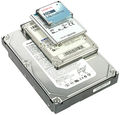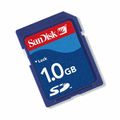Laptop Evaluation Checklist
The laptop you are inspecting has not yet been evaluated. The goal of the evaluation process it identify the hardware in the laptop, find any major issues or problems it may have, and determine whether we will recycle it or refurbish it. Take care to make note of anything about the laptop that may be important to the Build or Quality Control processes. Remember to take your time and ask your instructor if you have any questions. Thank for your help!
1. Data Security Check
We are responsible for securely wiping or destroying any data storage device that is donated to Free Geek. This is the most important step in this process. In most cases this means removing hard drives from computers so the data can be wiped, but keep an eye out for other kinds of data storage devices.
Check for Hard Drives
☐ Separate any hard drive caddies and adapters from the hard drive.
☐ Tape them (along with their screws) back inside the hard drive bay. These should stay with the system unless your instructor needs them for parts.
☐ If a hard drive or other storage device is found, it should always be given to your instructor.
☐ Some laptops (especially larger models) may have two hard drive bays, so don't stop looking just because you've found one.
Check for Other Storage Devices
☐ Check the Optical Drive for disks.
- You can manually open the drive by pusing a paper clip into the small quick-release hole in the drive faceplate.
☐ Look inside and around the chassis for other less common storage devices, such as:
- 1.8” or other small-form-factor hard drives
- Mini PCI, mini-PCIe, or mSATA solid state drives (SSDs)
- SD cards or MemorySticks
- SIM cards (usually under the battery)
- Floppy disks
- PCMCIA (PC Card slot) hard drives
- Examples
2. Physical Evaluation
Take a close look at the laptop you are evaluating. Inform your instructor if you find any of the following:
☐ Floppy Drive
☐ Missing cover plates on the bottom of the laptop
☐ Missing Battery
☐ Missing Optical Drive
☐ Missing keyboard or individual keys
☐ Cracked or broken hinges
☐ Cracks, discoloration, scratches, or marks on any surface
☐ Evidence of liquid spills or oxidation residue
☐ Dirt, dust, cat hair and/or grime above and beyond what can be cleaned
☐ Damaged ports or power jack (look very closely)
☐ Visible screen damage (look for hairline cracks or splatter marks inside the screen)
Stop here and check with your instructor if the laptop has any of these issues; they may have you go through the Recycling or AS-IS process instead.
3. Find an appropriate AC adapter
Requirements
For an AC adapter to power the device correctly, it must:
- Match the input voltage (V) of the laptop exactly.
- Match or exceed the recommended amperage (A).
- Have a plug that fits into the laptop snugly and provides power.
☐ Find the input voltage and amperage listed on the laptop. This may be printed on the back of the laptop, or on the chassis under the battery.
☐ Find an AC adapter that matches the voltage and amperage listed on the laptop. You will be looking in the output section printed on the AC adapter, which should look like this:
INPUT: 100-240V~1.9A
50/60Hz
OUTPUT: 16V ⎓ 4.5A
Tip
AC adapters are sorted in bins by voltage, amperage, and brand; the bins are color-coded by brand.
4. POST
☐ Try turning the machine on.
- If the system loads the BIOS splash screen, you can proceed to next step.
- If the system does not boot, shuts itself off, or has video problems, use the Laptop POST Troubleshooting Guide in section (A-1) of the Appendix.
5. Determine Specifications
For determining system specs, Free Geek now has a CPU Lookup tool accessible from the Laptop Network Boot menu.
- Access the Network Boot menu:
- Make sure you have a working network cable plugged into the laptop.
- Power on the laptop.
- Use the Network Boot key (usually F12) or Boot Device Menu (F9, F10, or F12) if available. If these are unavailable, enter the BIOS and make sure Network/PXE/LAN boot is enabled, then save and exit. The system should now boot from the network.
- Select Laptop Build from the menu.
- Select CPU Lookup. The CPU Lookup tool will now try to match the CPU detected in the system with information in our database. If it finds a match, it will display information about that CPU, including which Spec Level it falls under. Write this information down.
- See Appendix A-6 for the CPU Charts and other ways to determine a laptop's specs.
6. Install Hardware
☐ Install RAM depending on the spec guide.
7. Keeper label
The Keeper label is used to:
- Keep track of basic hardware information.
- Track the laptop through RAM testing (called memtest), battery testing, and the build process.
- Transfer notes about the laptop from builder to builder, and the instructors.
☐ Tape the Keeper label to the laptop lid with full strips of masking tape down the left and right sides of the label.
☐ Fill out these fields:
- Laptop make and model
- CPU type and speed
- RAM size and speed
- Hard drive type and size
8. Begin Memtest86+
☐ Put the laptop on the testing shelf paired with the AC adapter and start Memtest. Full instructions are in the Memtest for Builders (A-3) guide in the Appendix.



